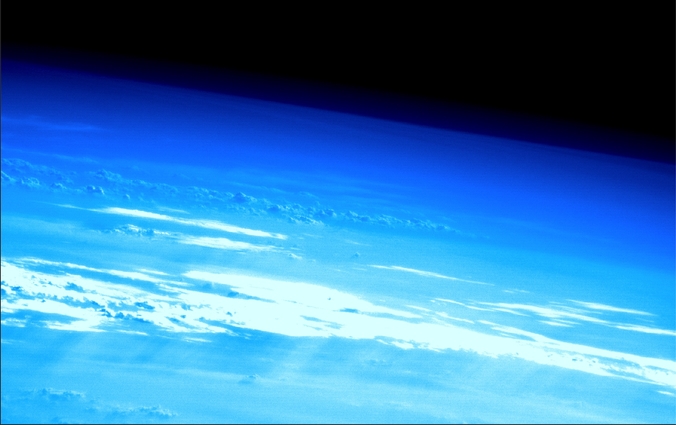LLNL’s prototype telescope now fully operational aboard the International Space Station
When SpaceX’s Dragon spacecraft docked with the International Space Station (ISS) on March 16, it delivered several thousand pounds of supplies for the crew as well as new hardware.
The hardware included the U.S. Space Force’s Space Test Program Houston 9 (STP-H9) platform, which houses a prototype telescope designed and built by Lawrence Livermore National Laboratory's Space Science and Security Program.
The Stellar Occultation Hypertemporal Imaging Payload (SOHIP) prototype telescope uses LLNL-patented monolithic-optics technology on a gimbal to detect and characterize gravity waves and high-altitude atmospheric properties such as temperature, pressure and air-density profiles at altitudes of up to 50 kilometers (or about 31 miles).
Now in “science mode” and fully operational aboard the ISS, Livermore’s prototype telescope is measuring atmospheric properties with high resolution at unprecedented altitudes.
“The Lab designed, produced and delivered its first-ever gimbaled monolithic telescope to the ISS for a total cost of $1 million. It’s working well and providing unique, never-before-seen images of the Earth’s atmosphere and stars.The team has achieved every goal it set out to accomplish. It’s an incredible achievement at this scale and cost,” said Ben Bahney, program leader for the Laboratory’s Space Science and Security Program.
SOHIP utilizes two monolithic telescopes attached to a gimbal assembly. The first telescope has a narrow field of view and observes a single bright star, the “science” star, as it is occulted — or partially blocked — by the Earth's atmosphere. The second telescope images a number of stars above the atmosphere to provide a set of reference measurements.
SOHIP measures the angular separation of the science star relative to the reference stars to determine its refractive bending. Scintillation of the science star also is measured by recording the intensity of the science star at rates of more than 1,000 frames per second.
The Python scheduling tool developed for SOHIP predicts the exact time and motor positions needed to capture bright stars setting in Earth’s atmosphere. SOHIP routinely collects anywhere from 6 to 16 occultations of bright stars per day, depending on the ISS’s orbit and the position of the sun, moon and stars.
Now that the team has calibrated the telescopes and sensors and made improvements to the flight software, they can begin to analyze the data sets. Once fully analyzed, these datasets will provide anisotrophic turbulence measurements with spatial resolutions less than three meters, a scientific first.
“By the end of June, we collected almost 200 occultations at roughly three-meter vertical sampling rates. This gives us data to investigate small-scale vertical gravity waves and turbulence at a large range of latitudes and longitudes,” said Dana McGuffin, an atmospheric scientist at the Laboratory who performs data collection with SOHIP.
“SOHIP has operated very well over its first 90 days on orbit,” said Lance Simms, SOHIP’s flight software and operations lead. “We have tracked a number of stars at 1,000 frames per second through the atmosphere, the gimbal’s motors are working better than we hoped for, and there haven’t been any unexpected crashes or major anomalies in the flight software/firmware.
“Our engineering team that designed and built SOHIP did a truly extraordinary job. And the Space Test Program deserves a huge amount of credit for providing such a superb platform to host our payload.”
With SOHIP’s successful launch, installation, and now delivery of datasets and images, LLNL has advanced the science of low-cost space-payload telescopes with next-generation capabilities in support of national defense and science.
“We’re looking at stellar occultations in new ways that could help with hypersonic-flight planning, which will enhance our understanding of upper-atmospheric weather. We also see future applications for this system in space-domain awareness. The SOHIP multidisciplinary team has opened up new possibilities for the Lab’s work in these areas,” Bahney said.
LLNL’s Laboratory’s Directed Research and Development program, an internal research funding program, provided funding for the SOHIP instrument design as well as the measurement of atmospheric properties with high resolution at higher altitudes; Laboratory licensing revenues funded the instrument itself.
Among the members of the Lab’s SOHIP team are: Simms, McGuffin, Minh Pham, David Patrick, Jordan Karburn, Collin Averill, Steve Hunter, Princess Corral, Jeff Klingman, Darrell Carter, Brian Baumann, Jon Gordon, George Danckiewicz, Pete Suspinskas, Matt Horsley, Phillip Cameron-Smith, John Ganino, Wim De Vries, Ryan Fellini, Frank Ravizza and Bahney.
Contact
 Stephen Wampler
Stephen Wampler
[email protected]
(925) 423-3107
Related Links
Prototype telescope designed by Lawrence Livermore researchers launched to the International Space StationStellar Occultation Hypertemporal Imaging Payload
Tags
Earth and Atmospheric ScienceAtmospheric, Earth, and Energy
Physics
Space Science Institute
Global Security
Physical and Life Sciences
Science
Featured Articles









